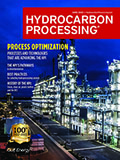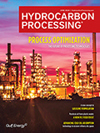
June 2022
Special Focus: Process Optimization
Molecular management, energy efficiency and carbon dioxide (CO<sub>2</sub>) emissions have become major focuses for petrochemical complexes, including aromatics plants.
The measured pressure drop of columns in air separation units (ASUs) is often reported as being higher than the predicted pressure drop.
Operators at refineries, petrochemical plants and power generation companies are under constant pressure to reduce maintenance and operational costs, boost productivity, minimize risk of unplanned outages and maximize time between overhaul periods.
Catalysts
Hydroprocessing catalysts are an essential part of the refinery involved in the treatment/conversion of most petroleum fractions, ranging from naphtha to residue.
Plant Design, Engineering, Construction and Commissioning
Inflation and supply chain disruptions are not new to the construction industry, but the severe combination of these factors and the rapid pace of change driven by the COVID-19 pandemic are unprecedented.
Maintenance and Reliability
Each year, significant economic losses due to corrosion failures occur in the refining and petrochemical industries; unfortunately, many of these losses could have been prevented.
100th Anniversary
The 1970s were marked by several historical events that affected not only the hydrocarbon processing industry (HPI) but nations around the world.
Maintenance, optimization, safety and digital technologies
Catalysts, polymer processing technology, synthetic lube oils, control systems
Carbon Capture/CO2 Mitigation
This article is the continuation of an article detailing the seven pathways to decarbonizing the oil and gas and petrochemical industries. Part 1, published in the May issue of <i>Hydrocarbon Processing,</i> covered sustainability and reviewed the following three pathways: green and blue hydrogen (H<sub>2</sub>); biofuels, renewable fuels and e-fuels; and the circular carbon cycle.
Biofuels, Alternative/Renewable Fuels
Anyone studying the development of the hydrocarbon processing industry over the last century will likely admire how far technologies have advanced, particularly considering the tools that were available in the industry’s early years.
Heat Transfer
Shell-and-tube heat exchangers (STHEs) are the most common heat transfer process equipment in all types of industrial plants.
Columns
The hydrocarbon processing industry (HPI) is filled with unique and innovative people that stive to provide technologies, processes and services to better the industry in which they work.
During their careers, most rotating machinery experts have dealt with the selection of advanced screw compressors.
Controlling costs is critical for any energy company. Firms may spend to grow through acquisition, develop new business, gain market share or invest in new opportunities.
Is there a consensus about a distillation column distributed control system (DCS) control strategy? Much has been written about this topic, covering configuration possibilities, constraints and interacting control considerations.
Trends and Resources
Over the past several years, the hydrocarbon processing industry (HPI) has been engaged in a whirlwind of peaks and valleys.
In 2020, the author’s company published the results of a survey that highlighted a significant shift to industrial autonomy, with as many as 89% of companies planning to increase the level of autonomy in their operations.
In a continued effort to serve the corrosion industry, Carboline has launched CarboNext, a program to educate, connect, support and engage with the next generation of engineers and professionals.

- Petrobras wrapping up due diligence to buy back refinery from Mubadala 7/26
- US court rejects EPA denials of 2022 small refinery biofuel waivers 7/26
- Mexico seeks more 2025 fuel import deals after refinery delays 7/26
- PETRONAS, Eni and Euglena reach FID to construct a biorefinery in Malaysia 7/26
- ExxonMobil signs carbon capture agreement with CF Industries in Mississippi (U.S,) 7/26
- WoodMac: LNG truck sales impacting Chinese road diesel demand 7/26
- Digital Exclusive: SPECIAL FOCUS: Digital Technologies—Utilize process simulation digital twin to optimize condensate yield
- Digital Exclusive-Flare system design: Liquid pockets in flare headers
- Hydrogen-rich content gasoline: A new concept for paraffinic gasoline reformulation
- Alarm rationalization at Kuwait National Petroleum Company (KNPC) refineries




